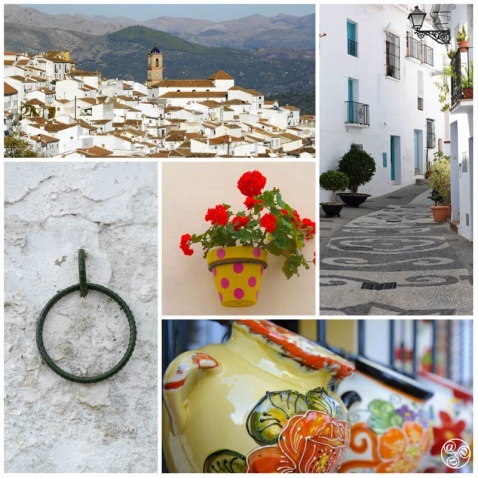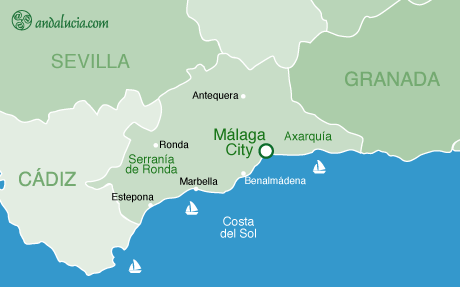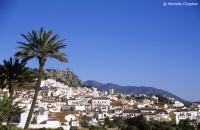
Malaga villages clockwise: Algatocin, Frigiliana, Mijas, Almogia, Estepona |
|
Highlights of Villages & Small Towns of Malaga province
Like neighbouring Cadiz province, Malaga is sprinkled liberally with pretty pueblos blancos, or white towns and villages, the most well-known of all these being Ronda. Malaga is inundated with visitors to its famous Costa del Sol and the pueblos blancos nearest this coastal strip are the most popular, but it´s relatively easy to find more remote villages that retain an away-from-it-all charm, such as those of the Axarquía region northeast of Malaga city.
Selected, approved Gaucin villas and village houses. Traditional, comfortable, quality accommodation from Andalucia specialists Rustical Travel.
Costa del Sol
West of Malaga city is the most visited stretch of the Andalucian coastline, the Costa del Sol. Purpose-built resorts of high-rise apartments line many of the beaches, but there is also the jetsetters' haunt of upmarket Marbella to explore, with an old quarter riddled with tiny streets that link pretty squares. Adjacent to Marbella is the glamorous marina of Puerto Banús, while further east are the hedonistic pleasures of Torremolinos, which has some great bars and clubs. Leaving these heady delights behind, head west to Estepona, which has managed to maintain a relatively low-key atmosphere, reflecting its former life as a fishing village.
In the immediate hilly hinterland of the western Costa del Sol are mountain villages popular with foreign visitors to the Costa del Sol, such as the settlements north of Marbella at the foot of the towering Sierra Bermeja. Istán nestles beneath the peaks of the Sierra Blanca, while Ojén is further east, on the A355, and beyond Ojén in a mountain valley is Monda and then Guaro. The attractive village of Benahavís north of San Pedro de Alcántara is well-known for its many excellent restaurants.
West of Estepona is the surprisingly unspoilt village of Manilva - given its proximity to the Costa - and, further inland along a beautifully scenic road, Casares. This village is in a spectacular position with its house clinging precariously to the sides of a rocky pinnacle, crowned by a Moorish fortress.
North of the coastal resorts of Fuengirola and Torremolinos there is the popular, pretty village of Mijas, with great views down to the coast, the historic village of Alhaurín el Grande that has vestiges of settlement traced back to Neolithic times, its much newer neighbour, Alhaurín de la Torre, and Coín.
On the eastern Costa del Sol close to Malaga city is Rincón de la Victoria, with a marine cave - the Cueva del Tesoro - believed to have hidden treasure (tesoro). Further east is the resort of Torre del Mar, which has an attractively revamped main paseo and a lively seafront.
Nerja is the most attractive town along this stretch of coastline, sheltering at the foot of the Sierra de Almijara. Don´t miss its magnificent tree-lined promenade, the Balcón de Europa, jutting out into the sea and giving stunning views along the rocky shore. Nerja is also famous for its cave, the Cueva de Nerja, 4km from town.
Villages of the Guadalhorce Valley
Easily accessible from Malaga are a series of village nestling in the Guadalhorce valley. The closest to Malaga on the A357 is Cártama, once a strategic stronghold for the Romans and the Moors who constructed a castle, today better known for its enormously popular Crocodiles Park. Just beyond is the small but historically interesting Pizarra. Further north is Álora, the biggest place along this route, with steep, cobbled streets leading up to a ruined Moorish citadel, now the town´s cemetery. It is tucked into the foot of a rocky cliff topped by a castle, which was first constructed by the Phoenicians.
Northwest of Álora is the tiny spa resort of Carratraca, whose sulphuric hot springs have been popular since the 19th century, when its waters assuaged the aches and pains of famous travellers - and hypochondriacs - such as the poet Lord Byron. Close to the Guadalhorce reservoirs, with a lakeside campsite, is Ardales. North of Ardales is Teba, whose streets are lined with many grand mansions. The village enjoys some of the best panoramic views in the area over a gently rolling plain clad in olive groves and cereal plantations.
Don´t miss the spectacular Moorish fortress of Bobastro, near the reservoirs, a site where the Muslims, rebelling against the Caliph of Cordoba, converted to Christianity and carved a mosque-like church in solid rock. East of here is the Valle de Abdalajis in an impressive mountainside location and near some excellent hang-gliding territory. At the foot of the magnificent limestone rock formations of the Torcal de Antequera Natural Area is the hill town of Villanueva de la Concepción.
Selected, approved Gaucin villas and village houses. Traditional, comfortable, quality accommodation from Andalucia specialists Rustical Travel.
Pueblos blancos of the Serranía de Ronda
The mountain range of the Serranía de Ronda is dotted with many hilltop whitewashed villages topped by Moorish castles. Since the 19th century when it attracted a whole host of illustrious visitors, the most popular of these has undoubtedly been Ronda. In a much-photographed stunning position on the top of the sheer-sided Tajo gorge, Ronda is remarkably appealing with a beautifully preserved old town and many great bars and restaurants.
To the north of Ronda are Arriate and Cuevas del Becerro, while south is the attractive Cortes de la Frontera, surrounded by cork groves, and the most famous place in the area, the delightful village of Gaucín. West of Ronda is Montejaque, perched on the mountainside overlooking the fertile olive groves below, and Benaoján, which is close to a famous cave, the Cueva de la Pileta, with some impressive prehistoric cave paintings and rock formations of stalagtites and stalagmites.
Off the well-beaten tourist track in the Genal valley, in the shadow of the Sierra de las Nieves Natural Park, is the village of Igualeja along with a string of hamlets, such as Pujerra, Júzcar, Cartajima, Alpandeire and Faraján. On the eastern side of the Sierra de las Nieves, and a gateway into the park, is Tolox, which boasts a well-known spa.
Selected, approved Gaucin villas and village houses. Traditional, comfortable, quality accommodation from Andalucia specialists Rustical Travel.
Northern historic villages
The main town to the north of Malaga city is Antequera, a town almost buried under its weighty, rich history with a plethora of monuments, such as a scattering of prehistoric dolmens, a Moorish castle, Roman baths and many fine churches. It´s a good base for exploring the three impressive natural sites nearby: the weirdly eroded limestone landscape of the Torcal del Antequera Natural Area, the magnificent gorge of the Desfiladero de los Gaitanes Natural Area and the lake in the Fuente de Piedra Natural Reserve, which attracts thousands of flamingos to breed in spring.
East of Antequera is the small, pleasant town of Archidona, with its 18th-century eight-sided Plaza Ochavada and an interesting church, the Sanctuario de la Virgen de la Gracia, just out of town. Thirty four kilometres east of Antequera is Villanueva del Trabuco, a pretty village in the foothills of the Sierra de San Jorge. Six kilometres south is the smaller Villanueva del Rosario, set in farmland of olive groves and wheat fields with a mountainous backdrop. North of these villages, close to the provincial borders of Granada and Cordoba, is another attractive village, Villanueva de Tapia.
Other towns and villages in the area include Fuente de Piedra, the closest village to the nature reserve of the same name that is famous for its flamingos; the town of Campillos, 25km west of Antequera between the Guadalhorce reservoirs and the Laguna de Fuente de Piedra; Mollina, 15km northwest of Antequera, a major wine-producing town; and Alameda, a few kilometres from a protected lake, the Laguna de la Ratosa Natural Reserve, where you can see flamingos in spring and summer, along with other aquatic birds.
Halfway between Malaga and Antequera is the hill town of Almogia, a Moorish fortified settlement with the remains of a castle.
Remote villages of the Axarquía region
The regional capital of this mountainous area is Vélez-Málaga, a market town well worth a visit with a lively market on Thursday. The limestone mountain range of the Sierra Almijara, part of the immense Sierras of Tejeda, Almijara and Alhama Natural Park that straddles Malaga and Granada provinces, looms over the picturesque Moorish village of Frigiliana, only 7km north of the coast and Nerja, Cómpeta, renowned for its sweet wines and surrounded by vineyards and, further south, the pretty mountain village of Torrox. To the west of the park is Comares, one of the highest villages in Andalucia and visible for miles around, and Colmenar, on the edge of the densely wooded Montes de Malaga Natural Park and named after the numerous beehives (colmenas) that produce the village´s honey.

